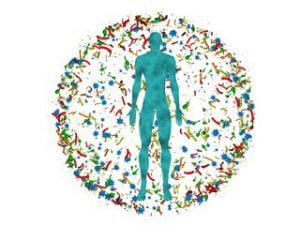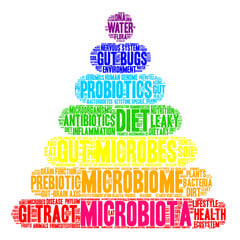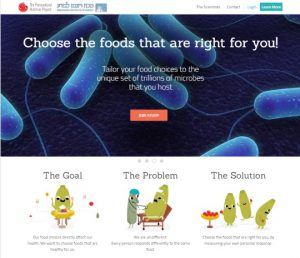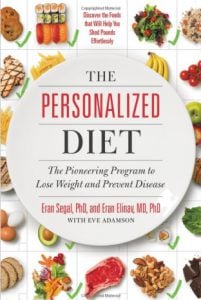A Microbiota Test To Personalize Your Diet
A science-based test for better blood sugar regulation with Dr. Eran Elinav.
Metabolic conditions like diabetes are on the rise, and the need for blood sugar management is critical. In this episode, Dr. Eran Elinav shares the science behind a new test that predicts your personal sugar level rise to foods, based on data from your microbiota, blood, body composition, and other clinical details. In the research, the personalized diet generated by the algorithm was slightly more effective in balancing blood sugar than following a diet created by an expert. Learn more about what steps you can take! (Plus, hear details on the first ever vaginal microbiome transplant.)
Episode Intro
Dr. Michael Ruscio, DC: Hi everyone, welcome to Dr. Ruscio Radio. Today I’m very happy to be here with a special guest, Dr. Eran Elinav. We’re going to be talking about a paper that he published a few years back in Cell. You may have heard of it. It was a very exciting paper that found a testing method, including testing for the microbiota, could help inform glycemic or glucose response to food or really predict it and help people achieve better glucose control, partially guided by what’s going on with their intestinal bacteria. Something that I’m very curious to explore more. Welcome to the show today.
Dr. Eran Elinav: Hi there, it’s a pleasure to talk to you.
[Continue reading below]
Study: Personalized Nutrition by Prediction of Glycemic Responses
- Measured: Microbiota, Blood Sugar, Body Composition, Lifestyle, Diet, Exercise
- One of the best predictors (out of the list above) of glucose level was the microbiota
Implications of the findings
- How diet, microbiota and metabolism interact
- To predict blood sugar response to foods
- A one-size fits all diet does not work
Weight loss implications
- While it has not been the primary subject of their studies, weight loss is likely an indirect benefit of normalizing blood glucose levels
Follow up study on pre-diabetic patients
- The week of good individualized diet improved blood sugar control significantly
- The week of bad individualized diet worsened their blood sugar control
- Compliance to diet is dramatically improved with this method
Could GI index be adequate
- Does not account for individual variants, GI is based upon individuals average response
Test available today/now?
- Day Two lab testing
- Microbiota was one of the most predictive aspects of the assessment
- This is combined with clinical features to replicate findings from Dr. Eran’s research
- He endorses its use
- Day Two has also replicated Dr. Eran’s findings with their own testing
Vaginal Microbiome Transplant
- First ever vaginal microbiome transplant
- Bacterial vaginosis affects ⅓ -½ of all women
- When severe, the bacteria can become antibiotic resistant
- 4 of the 5 women went into remission for an extended period of time for the first time ever
Where to learn more?
In this episode…
Episode Intro … 00:04:40
The Study and its Implications … 00:08:25
The Glycemic Index, Debunked … 00:16:49
Sticking Close to the Science … 00:23:36
Research Takeaways … 00:31:26
Follow-Up Study … 00:36:07
Vaginal Microbiota Transplant … 00:43:19
Episode Wrap-up … 00:48:42
Download this Episode (right click link and ‘Save As’)
DrMR: Can you tell people a little bit about your work? You’re doing quite a lot of work, you just informed me here before we started the recording that you have performed the first VMT of Vaginal Microbiota Transplant, which we’ll come back to a little bit later. You’re certainly ensconced in this. Tell us a little bit about your background and how you got into the paper that you published in Cell, with a very interesting blood glucose findings associated with it.
DrEE: Well, my personal background started from clinical medicine. I studied medicine and practiced as a clinician, doing an internship, residency and fellowship in clinical gastroenterology, until I decided to focus more on research. Performed a PhD in immunology, and then basically crossed the line, and became a basic scientist who integrates a lot of the clinical questions that were interesting and important in my previous phase of career. And what I do in the last few years is head quite large laboratory at the https://www.weizmann.ac.il/pages/ in Israel, which focuses on the study of microbiome. It is huge, immense, and quite poorly understood world of microbes that resides within each and every one of us from the moment we are born until the moment we die.
In the last decade or so this field has enormously expanded to include not just us, but many other research groups that are slowly understanding that the communications between us and our internal microbes that live on every body surface in our body, that communicates with the outside world are fundamentally important to almost any healthy function of our body and are involved in many conditions that may turn out to be common diseases that impact the human body. And we believe that by understanding the contribution of the microbes within our body to these disease processes, we may potentially be able to identify new therapy options.
DrMR: One of the diseases that’s becoming increasingly more common is prediabetes and diabetes. This is one of the things that your paper from a few years back in Cell was really hoping to shine some light on. And it seems that through a rigorous study design set up, you were able to validate this predictive model for how we know how a given person will respond to given meal contents, mainly carbohydrates. Can you tell people a little bit more about your study and some of the main implications of your findings?
The Study & its Implications

DrEE: First, I would like to mention that the study was strategically performed in close collaboration between my lab and the lab of my good friend and colleague, Eran Segal who is a mathematician also from the Weizmann Institute of Science, and he’s engaged in this, and many other studies that we perform in close collaboration. When we first started studying the microbiome, less than eight years ago, we realized that while there are many different features that impact the composition and the function of our gut microbiome, nutrition seems to be the most potent factor that determines the different compositions of different microbes, and how they function in different people.
As a result, we focused on trying to understand the interaction between human nutrition and the microbiome and how these interactions may potentially affect our metabolic health or our risk of developing metabolic diseases such as obesity, type 2 diabetes, prediabetes, fatty liver. Collectively this is termed the metabolic syndrome and it constitutes one of the worst epidemics in human history with trillions of people suffering from these disorders. When we started looking into these potential microbial contributions to metabolic health or to obesity and diabetes and the resulting complications of these diseases, and we found that everything that we do, from medical treatment down to you and I trying to come up with a healthier diet, is based on one of several grading systems that give different numbers to different foods and food components.

What we do in our daily lives, even without thinking about it, is we try to mix and match these different values that were given to different foods and tried to come up with a healthy diet. Calories, for example, are such grading system. An even more common grading system for food that is used worldwide is called the glycemic index. This system, which is integrated into many dietary approaches, is based on very small-scale human studies from the 1970’s in which usually 10 healthy individuals were given an identical food and then their blood sugar levels were measured for two hours after they ate. The spike in blood sugar levels would be averaged in these 10 individuals, that average would be given a number, which would then become the glycemic index of that food.
For example, if you were to take 10 individuals and give them an identical piece of celery, and measure their blood sugar levels for two hours, the slow spike that you would measure in their blood sugar would be given as the glycemic index of celery. If you ask the same 10 people to eat chocolate cake, then the average spike would be higher, and this higher number would be considered the glycemic index of chocolate cake. If you look in your smartphone, you would find endless tables that give glycemic index to every given food component or food on earth.
Many, if not most of the diets that we try to apply in our daily lives are based in one way or another on this glycemic index value. And what we did in our study, which is termed the Personalized Nutrition Project, is revisit this concept and basically do it using much more elaborate technologies and a much larger number of individuals that would take the test. So instead of measuring 10 individuals, we measured 1,000 individuals. When we did this, and we gave them one of several test foods and also measured hundreds of different foods that they consume during the daily lives, we identified a major problem in how we understand this grading system that has basically ruled our lives for so many decades.
When we took these 1,000 individuals and gave them an identical piece of white bread or even 50 grams of glucose and measure the spike in blood sugar level. We were surprised to find that while the average spike was exactly the glycemic index of whatever food we gave these 1,000 people, the individualized changes in blood sugar level were highly variable. In other words, you could give 1,000 people 50 grams of glucose of sugar, and some of these people would not even spike at all, while others would spike to diabetic levels. Which told us, intuitively, that this concept of a one size fits all diet or dietary intervention, can likely not exist in real life because if your glycemic index to a given food is the opposite of mine, then the same diet cannot work for both of us, at least in lowering blood sugar levels.
This was a great motivator to revisit this field by trying to come up with a system that would measure these individuals and try to generate a healthy diet, not by grading the foods, but by grading the people. This is exactly what we did in this study. We took 1,000 individuals and we asked them to give us a week of their life. During this week we generated an unprecedented amount of person-specific data, including a very deep dive into characterizing their microbiome with our most advanced methods. Also, by taking many blood tests, by measuring these people for Prometric measurements. We generated a smart phone app for this project that enabled, during the week of follow-up, individuals to provide us with real life data about what they were doing in their daily lives. When they were going to sleep, when they were waking up, what they were eating, how much they were eating.

This created a huge amount of person-specific data, and we connected each of the 1,000 individuals to a continuous glucose monitor, which measured their blood sugar levels every five minutes for an entire week. To give you a flavor of the difference between the original studies in the 1970’s and ours: In the original study, each of these 10 individuals were measured for blood sugar level by skin pricking six times per person. In our study, we are talking about 1,000 people each being measured 2,500 times during the week of follow-up.
This generated a very sensitive and rich dataset. And what was done after this huge amount of person-specific data was collected, was to take all of this data for each given individual and use artificial intelligence and machine learning technologies in order to try and devise a personalized algorithm that would accurately predict a person’s response in terms of their sugar level rise to any given food. Including foods that they haven’t consumed during the week of follow-up.
When we did this, and compared the accuracy of how we can predict the responses to different foods today as compared to this new personalized science driven high-tech approach, we found that the new personalized method was dramatically superior and more accurately predictive of the response to any given food. This allowed us, for the first time, to generate an accurate personalized diet for each individual that would more reproducibly and effectively lower their blood sugar levels.
DrMR: Now, what’s so fascinating about this is the ability to predict what we otherwise wouldn’t be able to anticipate. One of the things I’m wondering as you’ve looked at this data, does there seem to be any type of macro trend that emerges? As an example, and I’ll paint this obvious just to make it clear.
The Glycemic Index, Debunked?

Let’s say you have a fairly high glycemic index food like rice or potatoes. Does it seem that the individuals who had more impaired fasting blood glucose at baseline, maybe those with higher or higher body fat, those people who already were expressing an inability to process carbohydrates well , did the worst with these higher carbohydrate foods or was there no trend that fit nice and neat into what we expected to find.
DrEE: It’s a great question. In the original study we measured 1,000 individuals. The spinoff company, who basically licenses the technologies and develops them for the general public after all of the initial discoveries and publications, has now completed the analysis on 50,000, so we have a very big data set. What’s fascinating is that we cannot guess, based on our prior scientific and medical knowledge, what an individual’s response will be to different foods. In other words, you can take a pre diabetic individual and that individual would react exactly the opposite way of what you would expect from these mass average studies. That person might not spike at all on rice or ice cream and spike on tomatoes.
With each person that we profiled, we still run into very counterintuitive results that suggest that without measuring, we have very little capability to tell a person what is good or what is bad to that person in terms of their glycemic responses. In fact, we’ve tested this on our own students and gave them different bad or good diets for different individuals and tried to have them guess, which is good and which is bad for a given individual. And after many of these drills, the responses were like the toss of a coin. There was a 50% success rate. Without measuring and without using these data collected from individuals, we do not have any good capability to predict or to recommend what would spike him or her and what would not.
DrMR: This leads to another question, but I want to impart into the question my circumspection. One of the things I don’t know about DayTwo is, are they offering the same multi analysis test where I know in your study you were looking at body composition measures, lifestyle, diet as well as the mapping of the microbiota to give a predictive analysis. I’m unclear if DayTwo is using that same comprehensive analysis or if they’re excising from your model, the microbiota aspect of it? Because, obviously that would tell us how translatable the potential predictive effect could be.
DrEE: As you know, our study was an academic study, it was funded academically and was motivated by serendipity and by curiosity to generate new data and new insights into nutrition, the microbiome and how they may impact metabolic health in humans. When we started this study, we had no idea what feature that we measured would have a bit bigger or smaller impact on the results. We basically try to measure as many features as possible. We put a lot of effort into measure the glucose continuously and to collect a huge amount of person specific data, knowing that maybe some of this data would be needed, and some would be less needed at the end.
We’ve gone through this really extensive academic drill, generated the machine learning algorithms, and once they were successfully validated – we can discuss later how they were validated in real life – we could revisit the algorithms, which are completely unbiased. They don’t ask for my permission on which feature to use or not to use in order to reach a good prediction for a given person.

Once they were developed, we could kind of dive back in and see what features they preferred and what features they didn’t care about. And when we did this, we were quite pleased and surprised to see that one of the groups of features that contributed the most to the ability of these AI technologies to predict a person’s glucose response, included features coming from the microbiome. These were not only features coming from the microbiome, these algorithms needed features related to the clinical status of the people and other features that were collected by their questionnaire.
This is important because once we understood what we were dealing with, we could gradually minimize the amount of measurements that we would need to generate from a given person in order to reach the same degree of predictability. And what they do, as the spin of company was started only after we completed our academic work, is trying to minimize the hassle associated with data collection as much as possible while generating a very accurate predictive capability. They reached a milestone where they can take a person’s microbiome, analyze the microbiome, plus a very limited set of clinical features and use only these measurements to reach a very comparable capability to predict their sugar response as the one that we’ve originally developed using all of the many features that we have measured. This system, with time and with many more thousands of people being sampled, has been greatly simplified and now people don’t have to go through all the steps that were part of the academic original research.
Sticking Close to the Science

DrMR: I am so happy to hear you say that because one of the things I have become increasingly suspicious of, and I’m sure you probably are frustrated by this also, are these companies that are popping up in association with the excitement regarding the research in the realm of microbiota and making claims that really aren’t substantiated and these super far reaching inferences, which I obviously strongly disagree with. However, in this case it sounds like they’re trying to stay close to science, but thankfully consolidate the model to the markers that are the most relevant. So, it sounds like they’re doing a great job there over a DayTwo.
DrEE: I couldn’t agree with you more. And I am very hopeful that they will continue along this very careful path of only offering data, insights and recommendations that are strictly based on the science and medicine that is quickly accumulating and increasing our capability to offer more. And of course, we as scientists are continuing our academic research in this, and many other directions in order to further deepen the science and make things even more accurate.
DrMR: One of the other questions that comes up when we have an academic center that produces a novel finding such as yours and then a company spins off from that and tries to offer a similar type of test. One of the questions I always wonder is, are they replicating the methodology of the test specifically? And I’m not sure how much you know about what they’re doing at DayTwo, but do you know, are they using the same or at least what you would consider close enough in terms of the specific methodology of the microbiota assessment itself?
DrEE: I’m not part of DayTwo, but of course, I am very well aware of what DayTwo is doing as one of their consultants. One of the very healthy features of DayTwo, at least in my opinion, and a show that they are trying to stick close to science, which is a great differentiator in this over-hyped microbiome field, is the fact that the first thing that they did before going out to the public, is to basically replicate our findings. So, they didn’t just license all the data and the insights and technology that we developed, they actually measured many people in order to try and regenerate the same or similar algorithm. To give you a comparison, we’ve done 1,000 people in the original study and DayTwo has already completed close to 50,000 people being tested.
Their database is exponentially increasing. One of the very important and careful validation tests that DayTwo has performed involves not just replicating findings in the Israeli population, which was the original population in our study, but reaching out and replicating in other populations. They have, for example, collaborated with the Mayo Clinic, in sampling close to 400 individuals in mid America. These individuals of course have a different microbiome and different dietary preferences. Basically, they used the same algorithmic approach in a completely different population and generated the same capability to personally predict the glycemic responses to food in that other population. This was very encouraging, and I am very hopeful that they would do the same with each new region that they expand to. Just to make sure that these approaches don’t have to be tweaked with different populations.
Sponsored Resources
Hi, everyone. Let’s talk about probiotics, which helped to make this podcast possible. Functional Medicine Formulations contains a line of probiotics that I personally developed, and I’m super excited to be able to offer you the same probiotics that I’ve been using in the clinic for years and are a byproduct of an extensive review of the literature plus my own clinical experience.
In this line, you will find my favorite three probiotics in all three of the main categories that work synergistically to help you fight dysbiosis, like SIBO, candida yeast, and H. pylori, help to eradicate parasites, help to reduce leaky gut and repair the gut barrier, and can improve gas, bloating, diarrhea, constipation, and may even improve mood, skin, sleep, and thyroid function because of the far-reaching impact of the gut. You can learn more about these at drruscio.com/probiotics.
DrMR: One other question I wonder about here. Of course, if we can help someone achieve better blood sugar regulation, there are many positives that they follow from there, obviously lower blood glucose and then a litany of comorbidities that would accompany high glucose. I am wondering, do you have any indication, and even if this is only some anecdotal observation as you’ve been working in this area, could this help people who otherwise have a hard time losing weight?

DrEE: Yeah, it’s a question that I am often asked. I must say that up to this point with this study and multiple follow up studies, focused specifically on weight reduction. Of course, weight reduction is closely linked to glycemic control and insulin levels, but it is also a very good multifactorial kind of dis-order that could be impacted by many other confounding factors. Weight reduction was never our primary outcome. However, I can tell you about our follow-up studies on prediabetic individuals who are being followed with this diet in comparison to the gold standard diets for a year and what those results looked like. But because weight reduction is very interesting and important to people, we measure it in every follow-up study that we undertake.
The data from 50 years of modern medicine is overwhelmingly supportive of normalization of blood sugar levels and normalization of insulin surges after a meal being directly linked to weight control. One would very easily extrapolate that by improving your glycemic control, using a dietary approach such as ours, you should control your weight. You should induce a weight reduction in cases where it’s needed or weight maintenance in cases in which you want to avoid weight gain. However, this is not a direct measurement, simply a measure or an expectation based on the literature. In our long-term follow-up studies, this is one of the things that we would be measuring, but our primary interest is to normalize blood sugar levels in the vast populations that are at risk of developing prediabetes or diabetes. In the US it involves around 40% of the adult population.

DrMR: That makes complete sense that you want to have one chief measure that you’re focusing on. Of course, as you said there does seem to be a pretty good correlation between blood sugar control and body weight. I think it’s a fairly reasonable influence for us to draw that we should see improvements in body composition as someone sees better blood sugar regulation. And I do want to hear more about your follow-up study in a moment. I want to sneak in one quick question before we touch that which is, oftentimes there’s a desire to say, “Well, it’s this one group of bacteria that are responsible for a given finding.”
Research Takeaways
And it’ll be nice if it was that simple, although oftentimes with the microbiota being so complex, and a certain skewing of phylogenetic realm of the microbiota may cause a problem in one person and no problem on another person. So they’re not only seems to be the bacteria themselves, but how the bacteria are interfacing with the host, making it very challenging to make a simple statement that if you have this one bacteria, or a heightened density of this one bacterial population that could correlate with X, Y, Z. But I’m not sure, are there any simple takeaways that you’ve seen from the research that you’ve done?

DrEE: It’s a great academic question that we follow-up on a lot. I can tell you that exactly as you stated, that the microbiome is very complex and we’ve used very comprehensive pipelines to characterize the microbiome, which are called shotgun metagenomic sequencing where we sequence using next generation sequencing of every gene of every bacteria within each microbiome configuration. This generates a whole lot of data, but it also highlights the variation between individuals in their baseline microbiome composition and function. If you profile two individuals deeply enough, you would find that each has a unique signature of microbes and microbial functions that characterize that person.
With that said, given the fact that we generated a huge microbiome data set as part of this study and the follow-up work being done by DayTwo, we can now start to look for microbial signatures that kind of form common denominators that may contribute to worsened or improved glycemic response. And we’ve already been able to generate a more crystallized mini signatures of microbes that seem to be differentially abundant in different people. But they always go in the same direction when glycemic responses are improved or worsened depending on the dietary regimen of the subject. In other words, you can use this huge amount of data in order to also advance towards understanding the core microbial compositions
that contribute towards a worsened or an improved glycemic response. And we’re making really great strides in better understanding of these mini signatures. Maybe in the future we would even be able to exploit them in different ways in order to further complement our quest towards a better glycemic response.
DrMR: Just to make sure I drive home, how complicated this is, and again, correct me if I am wrong here, but it sounds to me you need artificial intelligence assisted analysis of what you’re seeing with the microbiota data in order to drive some of these recommendations. Is that correct? Is through that much data?
DrEE: Absolutely. This data is complicated beyond any imagination because it’s rich, it’s diverse. You can dive deeper and deeper into this data. We still have 30 or 40% of the data that we collect from each person, which we call dark matter, which we don’t fully understand. There is really enough stuff there to keep us busy for the next two decades.

DrMR: I mean the reason why I pointed out is sometimes I think a healthcare consumer will be given a recommendation based upon a commercially available microbiota mapping test and told, “Well, the reason why you’re having a hard time with your weight, or your blood sugar is because of this one simple finding from this analysis.” And if it were only that simple, but I point that out to caution people that unfortunately it’s not quite as simple as saying, “Well this ratio is skewed and that’s the source of your weight gain and your high blood sugar.”
DrEE: I couldn’t agree more, and I would recommend our listeners to follow a healthy skepticism. If someone offers you a very simplified kind of rule that would solve all your problems based on the microbiome, I would take it with a grain of salt to put it mildly.
DrMR: Yeah. Agreed. Do you want to tell us a few points about your follow-up study that you mentioned a minute ago?
Follow Up Study

DrEE: Already within the published work that we’ve done, following the development of this new personalized approach, we wanted to put ourselves to the real-life test, so we recruited a new cohort of pre-diabetic individuals. Individuals that already suffer from problems in their blood sugar maintenance and have a great 70 to 80% chance of developing full blown type 2 diabetes within the next decade of their life and we currently very little to offer them. So, we recruited these individuals, we put them through our process and now we ask the computer to generate a set of good and bad diets per each individual. Of course, these were personalized diets that there were different between different individuals and we as the good and bad diet per given individual would be isocaloric so we wouldn’t have to blame the calories. Then each of these pre-diabetic individuals ate his or her personalized good diets for a week and then they’re personalized bad diets for a week. The diets were, as I said before, very counterintuitive. Some people Sushi was bad, in others, Sushi was good. In 70% of the population that we measured; Ice cream did not spike blood sugar. Until we measured, we couldn’t really tell what is good and what is bad per given individual. But the take home message was, that in this preliminary study, even a short-term intervention with a personalized good diet improved significantly the blood sugar controlling these pre-diabetic individuals while the week of bad individualized diet worsened their blood sugar control.
What we’re doing at the moment is finalizing a much larger prospective experiment where we recruited 200 pre-diabetic individuals and divided them into one group that followed the gold standard American Diabetes Association diet in a very strict manner while the other group followed the personalized dietary approach for a whole year. This long follow-up and intervention period allow us for the first time to really look at more clinical features such as diabetic control, maybe fatty liver, progression from pre-diabetic to diabetes or maybe reversal of prediabetes over the year of follow-up. We’ve completed our analysis or assessment of the last patients just this month and now we’re analyzing the huge amount of data that was collected. So, the jury is still out there, but we hope that in a few months we’ll be able to come up with our final conclusions and to share them with the public.
DrMR: One of the hopes that runs through my mind as you say that, and not that I am trying to give people a license to eat unhealthy food, but if we could find a way to tell someone, okay, “We’re trying to improve your blood sugar, we want you to eat healthy, but if you’re going to eat off plan, if you need a little indulgence, here are the ‘unhealthy foods’ that your blood sugar will be least affected by.” That could potentially be a huge win from a compliance perspective.

DrEE: Absolutely and one of the things that we are ready can say for sure, even with this unfinished, large scale study is that the fact that we are measuring people and enabling in a very personalized manner to play around with different combinations of food that are still good for them, dramatically increases compliance. Even if you look at the vast literature on, for example, what the American public has been doing trying to follow-up our recommendations, people generally do what they’re told in a fairly good manner. But the recommendations that we provided them were not working. Eventually, people just stopped following them because nothing good happens.
The other set of approaches or recommendations include diets that are so restrictive that they basically cut off a whole family of nutrients, which causes a weight reduction in the short term because these diets are associated with caloric restriction, but they’re incompatible with life. You cannot live your entire life without consuming any carbohydrates or any fat. The fact that we are personalizing the diet not only introduces numbers and data points that are much more accurately predictive of people’s responses, but they allow to mix and match different combinations. There are hardly any foods that should be totally avoided. If a food score is very bad for you, you can combine it with other foods until you reach a much better score. It’s all about the combinations of foods, which is less restrictive and causes a much better compliance over long term periods.

DrMR: Yeah, I mean that’s such an exciting prospect and as someone who works with a patient population that sometimes need to be on a somewhat restrictive diet, I see firsthand how psychologically challenging that can be for patients. And that’s one of the main reasons why I’ve been an advocate of having people not only eat healthy but also remain cautious not to try to force someone into overly restrictive diet. Because there are negative ramifications to that.
DrEE: Yeah. And I would even add that as a clinician since we were so ineffective in making good recommendations to the public, in some cases we fell into the trap of basically blaming the people for not losing weight. And this is a very dangerous, slippery slope because what we see from our data is that people shouldn’t be blamed. It’s just the recommendations that were provided them so far, were probably not sufficiently effective. This blame game is very psychologically dangerous, and it’s also scientifically probably wrong.
View Dr. Ruscio’s Additional Resources
Vaginal Microbiota Transplant
DrMR: Shifting gears here for just a moment, you mentioned the Vaginal Microbiota Transplant, or VMT. Tell us a little bit about what you found in that recent study.

DrEE: So in general, we and most other research labs focusing on the microbiome, devote most of our studies to the gut microbiome, which is the densest population of microbes in our body, and probably the most important population of microbes, because they’re so intimately involved with processes related to digestion, absorption and metabolic health in the gut. However, we shouldn’t forget that our body is comprised of many other microbiomes in every surface of the body that interacts with the outside world. We have a microbiome in our mouth, we have a microbiome in our respiratory system, in our urogenital tract, in our skin. Each of these microbiomes is super interesting because it has evolved together with the host to generate the functions that are specific for that organ. The microbiome of the skin would provide functions that are important for the skin, or the microbiome of the gut would provide completely different functions that are specific to the gut.
We increasingly devote our efforts to try and scrape the surface in understanding these other microbiomes, which are much harder to study because they represent what we call low-biomass, they’re much less bacteria in them, so it’s more technically challenging to study them. Our dive into the vaginal microbiome was done in close collaboration with a very talented OBGYN clinician, whose name is Dr. Ahinoam Lev-Sagie, one of Israel’s biggest vaginal disease experts. One of the most common female diseases in that respect is called bacterial vaginosis. It’s exceedingly common disease that impacts in average one third to one half of all women. It is driven by community changes in the microbes that normally inhabit the vaginal area and provide vital functions to this particular organ. Once this population changes towards a less healthy population, then affected women start suffering of various symptoms, which can become very, very severe and very life debilitating both from the angle of relationships and the intimate relations and social segregation, but also severe bacterial vaginosis is dramatically associated with higher risk of developing a sexually transmitted disease, obstetric complications such as infertility, early birth and so on. This is a very important disease and the women that suffer from the most severe end of the spectrum, estimated to comprise around 4 to 5% of all women worldwide, are actually suffering from a disease for which we have very little to offer outside of antibiotics, to which the bacteria often become resistant.

This is a great unmet need. We’ve learned a lot from what we call fecal microbiota transplantation, which has been very successfully used in some cases of hospital acquired infection in the gut and consists of a brute force replacement of a sick person’s gut microbiome by a healthier microbiome. This was associated with amazing rates of cure of some hospital acquired infections. We asked ourselves whether we could use the same approach, but this time looking at the vaginal microbiome in women suffering from severe form of bacterial vaginosis. And what we’ve just completed is the exploratory part of the study in which we developed for the first time, this new approach and applied it in five females suffering with the most severe bacterial vaginosis that you can imagine with the complications associated with it and no treatment for decades of follow-up.
When we performed this transplantation, after calibrating it from three healthy volunteers, we were able to completely cure four of the five women who went into a very complete long-term remission, which they’ve never experienced in their life. The fifth person experienced what we call a partial remission, meaning that we significantly improved her clinical symptoms, but when you look at the microscopy, the changes seem to be milder. But nonetheless, this seems to be the first step towards hopefully introducing some form of treatment for a very widespread disease that so far has not been associated with a very efficient treatment.
DrMR: It’s so interesting to ponder how antibiotics were the miracle discovery of a few decades ago. And now it seems that there’s this renaissance of bacteria with such a broad range of applicability, it’s so exciting to consider what the future’s going to hold as a treatment like this perhaps gets more and more dialed in and able to be offered to these women who are suffering with this non-responsive bacterial vaginosis. That’s a fascinating finding and congratulations on that.
DrEE: Thank you, and congratulations to the students and to the clinicians who’ve headed this study successfully.
Episode Wrap Up
DrMR: Is there anywhere that you want to point people online, a website, a book, anywhere where they could come across your work if they wanted to read more?
DrEE: Well, Eran Segal and myself have written a book called The Personalized Diet, which has been translated to many different languages. We try to provide an insight into our and others microbiome research, especially focused on nutrition, and the insights that were gained in a decade of microbiome research in how to improve human nutrition in a layman’s language, so this is one place in which you can learn about what’s going on and what’s been achieved. What are the still ongoing questions, and also this book gives some very simple do it yourself methods to try and personalize your diet even without going to the full blown DayTwo kind of approach. You can do this by just taking a glucometer that you can buy in your local pharmacy and basically testing your response to different foods that are part of your normal diet at home.
This is a simple way of course, it will not give you this full spectrum of responses to foods that you’ve never tasted or food combinations, but it could already generate a lot of insights on foods that you commonly consume and may not be good for you. This gives you the tools to possibly change those into other combinations that would be better off in terms of inducing glucose spikes in your body. So, this kind of a simplified do it yourself approach, that is very cheap and very accessible is also something that we described in this book as a means of providing some information to the general public.
DrMR: We’ll find a link there and include that in the transcript. Well, Dr. Eran this has been a fantastic conversation, I love the research that you’re doing and it’s great that we have for our audience, at least a lab to point them to in case they wanted to start experimenting with some of this stuff on their own.
So just again, thank you for the work that you’re doing and for taking the time to discuss it with us today.
DrEE: It’s my pleasure and thank you very much and good night.
DrMR: Thank you.
Dr. Michael Ruscio is a DC, Naturopathic Practitioner, researcher, and clinician. He serves as an Adjunct Professor at the University of Bridgeport and has published numerous papers in scientific journals as well as the book Healthy Gut, Healthy You. He also founded the Ruscio Institute of Functional Health, where he helps patients with a wide range of GI conditions and serves as the Head of Research.What do you think? I would like to hear your thoughts or experience with this.
- Get help using this information to become healthier.
- Get your personalized plan for optimizing your gut health with my new book.
- Healthcare providers looking to sharpen their clinical skills, check out the Future of Functional Medicine Review Clinical Newsletter.









Discussion
I care about answering your questions and sharing my knowledge with you. Leave a comment or connect with me on social media asking any health question you may have and I just might incorporate it into our next listener questions podcast episode just for you!